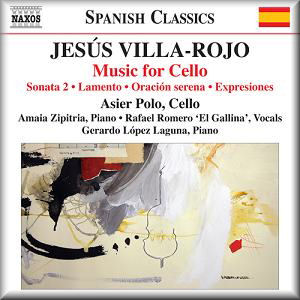 |
 |
|


alternatively
CD:
MDT
AmazonUK
AmazonUS
Sound Samples & Downloads
|
Jesús VILLA-ROJO (b.1940)
Music for Cello
Sonata no.2, for cello and piano (2009) [20:20]
Lamento (version B), for cello, ethnic voice and cello ensemble (2008) * [13:13]
Oración Serena, for cello and piano (2004) + [9:26]
Expresiones, for solo cello (2004) [26:16]
 Asier Polo (cello, including *4 pre-recorded cello parts)
Asier Polo (cello, including *4 pre-recorded cello parts)
Amaia Zipitria (piano)
Gerardo López Laguna (piano) +
Rafael 'El Gallina' Romero (ethnic voice)
rec. Musigrama, Madrid, 2-3 April 2009; 29-30 January 2009 (Expresiones); 24-26 June 2009 (Sonata). DDD
 NAXOS SPANISH CLASSICS 8.572564 [69:15]
NAXOS SPANISH CLASSICS 8.572564 [69:15] 
|
|
|
This CD brings together four recent chamber works for cello
by leading Spanish composer Jesús Villa-Rojo. It constitutes
a follow-up to the warmly received Marco Polo disc of his orchestral
music, which included his Cello Concerto no.2, also played by
Asier Polo - see review
of the re-release by Naxos in the same 'Spanish Classics' series.
Those new to Villa-Rojo's music will be surprised to learn that
he was for a long time a prominent figure in the Spanish avant-garde.
He produced numerous experimental works that employed indeterminacy,
electronics and multimedia. Aside from the ethnic voice in Lamento,
all post-modernist tendencies have been dropped and the modernism
softened to give a set of works that most listeners should find
at the very least palatable, but more likely rather attractive.
It is no great leap to believe that even Johann Sebastian Bach
would have admired Villa-Rojo's suite for solo cello, the aptly-named
Expresiones; this despite - and likely because of - its
lite-modernist elements. This extended, seven-movement work
is a fine vehicle for cellists. Indeed it’s challenging to play
but appealing to audiences. At the other end of the recital
is the Second Cello Sonata, which, according to the notes, is
"a monument to abstraction as a source of immediate emotion",
whatever that means. Spirited, spiky and sombre, it is reminiscent
of Prokofiev and pleasing to head and heart in a similar fashion.
That said, the final movement does seem a couple of minutes
too short.
'Version B' indicates that the solo cello in Lamento was
originally a saxophone. The effectiveness of El Gallina's flamenco-style
growlings is up for discussion - it may be that they subtract
more from the already powerful cello parts than they add, especially
as the vocal part is also clearly pre-recorded, reverberating
and shifting disconcertingly from one channel to the other and
producing a rather lamentable New Age effect. The description
in the notes of Lamento seems to bear little resemblance
to what happens in the work. The idea, for example, that "the
vocal part is exhaustively developed" is laughable. The
notes, in fact, are often rather fatuous or self-indulgent.
Is the reader told anything about Oración Serena, for
example, by a 'description' like this: "A journey into
ourselves and back again: is this music as psychology?"
Better just to say that this 'Serene Prayer' is an elegiac tribute
to the victims of the terrorist attacks in Madrid in March 2004,
and leave it at that. Villa-Rojo's poignant music will always
say a lot more than any waffle.
The notes do not say why Asier Polo plays all the cello parts
in Lamento - does Villa-Rojo specify this in his score?
He does a fine job in any case, performing throughout with great
technical confidence and communicative commitment. There’s a
sureness of touch about this playing and expressive insight
into the depths of Villa-Rojo's intelligent, memorable music.
Both pianists also play their part commendably, but let this
be the last heard of El Gallina on Naxos.
Sound quality is very good. The superscript numbers used to
indicate who plays what on the back inlay do not quite add up.
Byzantion
Collected reviews and contact at reviews.gramma.co.uk
|
|

